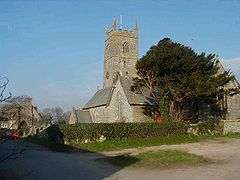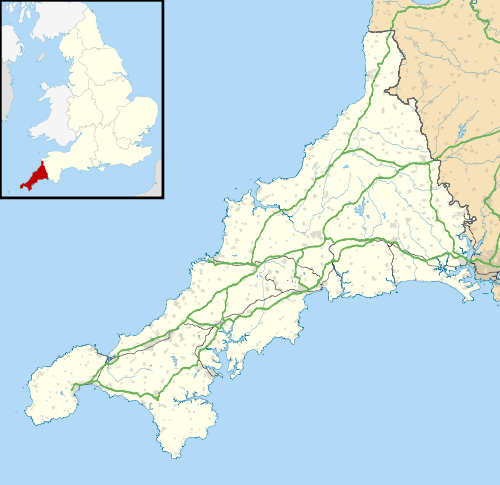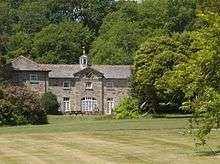Crowan
| Crowan | |
| Cornish: Egloskrewen | |
 Crowan parish church |
|
 Crowan |
|
| Population | 2,454 (2011) |
|---|---|
| OS grid reference | SW645345 |
| Civil parish | Crowan |
| Unitary authority | Cornwall |
| Ceremonial county | Cornwall |
| Region | South West |
| Country | England |
| Sovereign state | United Kingdom |
| Post town | CAMBORNE |
| Postcode district | TR14 |
| Dialling code | 01209 |
| Police | Devon and Cornwall |
| Fire | Cornwall |
| Ambulance | South Western |
| EU Parliament | South West England |
| UK Parliament | St Ives |
Coordinates: 50°09′47″N 5°17′38″W / 50.163°N 05.294°W

Crowan (Cornish: Egloskrewen)[1] is a village and civil parish in Cornwall, England, United Kingdom. It is about three-and-a-half miles (6 km) south of Camborne.[2] The River Hayle rises near Crowan and flows through the village and the railway branch to Helston passed nearby.
Crowan had a population of 2,375 (2001) which had increased to 2,454 in the 2011 census.[3] Crowan Churchtown is not the largest settlement: there are villages at Praze-an-Beeble, Nancegollan, Bolitho and Leedstown and a hamlet at Black Rock (on the B3280 road four miles (6.5 km) south of Camborne and five miles (8 km) north of Helston).[2] The hamlets of Carzise, Clowance Wood, Drym, Fraddam, Gwinear Downs, Horsedowns, Nine Maidens Downs, Noonvares, Paul's Green, Releath, Townshend and Tremayne are also in the parish.[4]
Notable buildings and antiquities
The parish church is dedicated to St Crewenna and is built of granite. The Latin name of the saint is first given as Crewanus in 1201 though later forms are in the feminine. St Crewenna was one of the Irish saints accompanying saints Germoe and Breaca.[5] The church is of the 15th century but was substantially restored in 1872. There are numerous monuments to members of the St Aubyn family. Sir John St Aubyn, 5th Baronet, is buried at Crowan; his monument was carved by William Behnes.[6] The three St Aubyn brasses (c. 1420, c. 1490 & c. 1550) are however now at Clowance.[7][8]
In some 18th-century documents there is evidence that the parish was called Uni-Crowan and this may be connected to the fact that the parish was in two parts, one in Penwith and one in Kerrier hundred. The Kerrier portion was once a separate chapelry and may have had St Uny as its patron saint.[9] Crowan feast was observed on the nearest Sunday to the eve of the Purification of the Blessed Virgin Mary.[10]
Clowance House was the seat of the St Aubyns (from 1671 they were the St Aubyn Baronets, but the legitimate line ended with Sir John St Aubyn, 5th Baronet in 1839).[11] Three years before his death the wings of the house burnt down on 10 November 1836.[12] The resort of Clowance estate offers swimming, tennis, gym and fitness facilities, a bar and an Italian restaurant.[13]
Prehistoric remains: Crowan parish has many remains of prehistoric times including barrows and stone crosses.[14]
Crowan Mill is an ancient mill used for grinding corn until 1946. It then became a pottery and later still a weaving mill.[15]
References
- ↑ Place-names in the Standard Written Form (SWF) Archived May 15, 2013, at the Wayback Machine. : List of place-names agreed by the MAGA Signage Panel Archived May 15, 2013, at the Wayback Machine.. Cornish Language Partnership.
- 1 2 Ordnance Survey: Landranger map sheet 203 Land's End ISBN 978-0-319-23148-7
- ↑ Office for National Statistics : Census 2011: Parish Headcounts : Cornwall Retrieved 2009-12-23
- ↑ Cornwall; Explore Britain
- ↑ Ellis, P. B. (1992) The Cornish Saints. Penryn: Tor Mark Press, p. 9
- ↑ Gunnis, Rupert (196u). Dictionary of British Sculptors, 1660-1851 (New rev. ed.). London: Abbey Library. ISBN 9780685279342.
- ↑ Dunkin, E. (1882) Monumental Brasses. London, Spottiswoode
- ↑ Pevsner, N. (1970) Cornwall, 2nd ed., revised by E. Radcliffe. Penguin Books
- ↑ Doble, G. H. (1960) The Saints of Cornwall; part 1. Truro: Dean and Chapter; pp. 97-99
- ↑ Cornish Church Guide (1925) Truro: Blackford; p. 10
- ↑ W. P. Courtney, ‘St Aubyn, Sir John, fifth baronet (1758–1839)’, rev. Hallie Rubenhold, Oxford Dictionary of National Biography, Oxford University Press, 2004; online edn, May 2010 accessed 30 March 2015
- ↑ "Fire at Clowance Park". West Briton. 18 November 1836. Retrieved 3 January 2013.
- ↑ "Clowance Estate". Clowance Lodges. Retrieved 3 January 2013.
- ↑ Ancient Crowan
- ↑ Todd, A. C. & Laws, Peter (1972) The Industrial Archaeology of Cornwall. Newton Abbot: David & Charles; p. 222
External links
![]() Media related to Crowan at Wikimedia Commons
Media related to Crowan at Wikimedia Commons